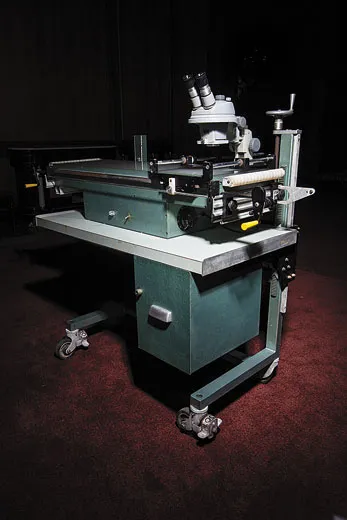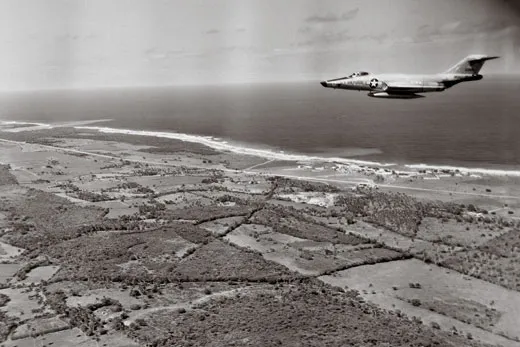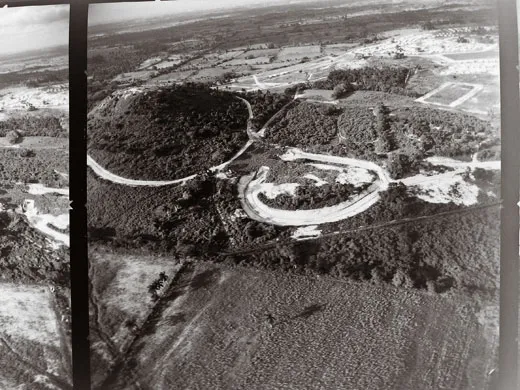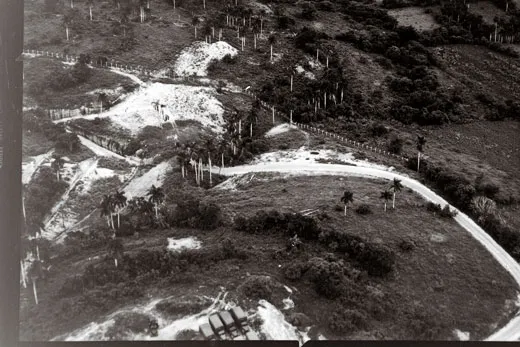The Photographs That Prevented World War III
While researching a book on the Cuban missile crisis, the writer unearthed new spy images that could have changed history
/https://tf-cmsv2-smithsonianmag-media.s3.amazonaws.com/filer/Cuban-Missile-Crisis-Managua-3-631.jpg)
On October 23, 1962, a U.S. Navy commander named William B. Ecker took off from Key West at midday in an RF-8 Crusader jet equipped with five reconnaissance cameras. Accompanied by a wingman, Lt. Bruce Wilhelmy, he headed toward a mountainous region of western Cuba where Soviet troops were building a facility for medium-range missiles aimed directly at the United States. A U-2 spy plane, flying as high as 70,000 feet, had already taken grainy photographs that enabled experts to find the telltale presence of Soviet missiles on the island. But if President John F. Kennedy was going to make the case that the weapons were a menace to the entire world, he would need better pictures.
Swooping over the target at a mere 1,000 feet, Ecker turned on his cameras, which shot roughly four frames a second, or one frame for every 70 yards he traveled. Banking away from the site, the pilots returned to Florida, landing at the naval air station in Jacksonville. The film was flown to Andrews Air Force Base outside Washington, D.C. and driven by armed CIA couriers to the National Photographic Interpretation Center, a secret facility occupying an upper floor of a Ford dealership in a derelict block at Fifth and K streets in Northwest Washington. Half a dozen analysts pored over some 3,000 feet of newly developed film overnight.
At 10 o’clock the following morning, CIA analyst Art Lundahl showed Kennedy stunningly detailed photographs that would make it crystal clear that Soviet leader Nikita Khrushchev had broken his promise not to deploy offensive weapons in Cuba. As the Cuban missile crisis reached its peak over the next few days, low-flying Navy and Air Force pilots conducted more than 100 missions over the island in Operation Blue Moon. While Kennedy and Khrushchev engaged in a war of nerves that brought the world the closest it has ever come to a nuclear exchange, the president knew little about his counterpart’s intentions—messages between Moscow and Washington could take half a day to deliver. The Blue Moon pictures provided the most timely and authoritative intelligence on Soviet military capabilities in Cuba, during and immediately after the crisis. They showed that the missiles were not yet ready to fire, making Kennedy confident that he still had time to negotiate with Khrushchev.
In the 50 years since the standoff, the U.S. government has published only a handful of low-altitude photographs of Soviet missile sites—a small fraction of the period’s total intelligence haul.
When I was researching my 2008 book on the crisis, One Minute to Midnight, I came across stacks of declassified American intelligence reports based on the Blue Moon photographs. I assumed that the raw footage was locked away in the vaults of the CIA until I received a tip from a retired photo interpreter named Dino Brugioni. A member of the team that prepared the photo boards for Kennedy, Brugioni told me that thousands of cans of negatives had been transferred to the National Archives, making them available for public inspection—at least in theory.
That tip launched me on a chase that led to a National Archives refrigerated storage room in Lenexa, Kansas, nicknamed “the Ice Cube,” the final resting place for hundreds of thousands of cans of overhead imagery taken during and after the missile crisis. To my surprise, no one had ever requested the Blue Moon material. Researchers are not permitted at the Ice Cube, but they may order ten cans of film at a time, which are then air-freighted to the National Archives facility in College Park, Maryland. There is just one catch: The cans are numbered in a seemingly haphazard fashion, and the CIA finding aid for the materials is still classified. Without it, requesting cans of Blue Moon film seemed like a hopelessly long shot.
I desperately needed the help of the researcher’s old friend, luck, and I got it when I stumbled across the identification number of one of the missile-crisis cans in a document I found in the Archives. Beginning with that number, I ordered random samples of cans until I had identified the shelves where the Blue Moon material was generally located. In all, I examined nearly 200 cans of film containing several thousand photographs.
The film brings home the dangers and difficulties the pilots faced. Working long before the invention of automated GPS systems, they navigated primarily with maps and compasses and used landmarks like bridges and railroads to find their targets. Flying over the treetops at 550 miles per hour, they had to operate a battery of cumbersome cameras while keeping an eye out for construction sites, military vehicles or other “suspicious activity.” To take useful pictures, they had to keep their platforms steady and level for the all-important few seconds they were over the target. The risk of mechanical failure or getting shot down was more or less continuous from the moment they entered enemy territory.
Each reel seats the viewer in the cockpit: Early frames typically show the ground crews at the naval air station on Key West checking out the cameras and planes. Surf splashes up against the Crusaders’ fuselages as they fly low across the Straits of Florida and cross the beaches of northern Cuba before heading over the island’s mountains. Plazas and baseball diamonds suddenly give way to missile sites and military airfields. In one series of images, the landscape goes suddenly haywire: The pilot has yanked his joystick to avoid anti-aircraft fire. As I reeled through the 6-by-6-inch negatives on a light table similar to the one the CIA’s photo interpreters used, I found myself holding my breath until the pilot escaped back over the mountains to the open sea.
In addition to bringing the viewer back into the moment, the photographs offer insights into the gaps in American intelligence-gathering—instances in which the CIA misinterpreted or simply ignored information it collected. One example is the photograph of a munitions bunker near the town of Managua, south of Havana.
“No apparent change,” CIA analysts wrote in an October 27 report. “Vines have grown on fence in some sections.” From Soviet sources, we now know that the bunker—which the CIA believed hid conventional munitions—was used to store warheads for the tactical FROG missiles that could have been used to destroy an American invading force.
A more ominous gap concerned the location of the warheads for the 36 medium-range missiles capable of hitting Washington and New York. The whereabouts of the warheads was critical, because the missiles could not be fired without them. Kennedy asked for the information repeatedly, but the CIA was never able to answer him definitively. By the second week of the crisis, the photo interpreters had concluded that the warheads were probably stored in a closely guarded facility near the port of Mariel. But by analyzing the raw intelligence film and interviewing former Soviet military officers, I discovered that they were wrong. The one-megaton warheads (each 70 times more powerful than the bomb that destroyed Hiroshima) were actually stored some 20 miles away near a town called Bejucal, a few miles south of the Havana airport. The CIA—and, by extension, Kennedy—was completely unaware of this at the time.
The giveaway was the presence of specially configured vans that were used to transport the warheads from Bejucal to the Sagua La Grande missile site starting on the night of October 26, as the crisis was approaching its height. The CIA analysts noted six strange-looking vans at the Bejucal site, but failed to understand their significance.
I was intrigued to learn that the Bejucal facility had been photographed on several Blue Moon missions. At the beginning of the crisis, a CIA briefer had even told Kennedy that it was the “best candidate” for a nuclear storage bunker and was marked for “further surveillance.” But the photo interpreters lost interest in Bejucal because of the seemingly lax security arrangements there. They noted that the site was protected by a single fence, rather than the multiple fences used to protect similar installations in the United States and the Soviet Union. As it turned out, the lack of security proved to be the best security of all, from the Soviet point of view.
What might have happened had the CIA interpreted the intelligence correctly? Had Kennedy known where the warheads were stored, he might have been tempted to order a pre-emptive strike to seize or disable them. The mission could have been a success, strengthening his hand against Khrushchev, or it could have gone badly wrong, resulting in firefights between Americans and the Soviets guarding the nuclear weapons. We will never know. As it was, Kennedy, armed with only partial intelligence about what the Soviets were doing, refrained from taking pre-emptive action.
At the same time, the photo interpreters did provide Kennedy with information that shaped his response to Khrushchev at several points. On October 26, they correctly identified a nuclear-capable FROG missile launcher photographed by Navy pilot Gerald Coffee the day before. But their most important contribution was their day-to-day assessment of the combat-readiness of the different missile sites. As long as the president knew the missiles were not yet ready to fire, he had time to negotiate.
That changed on October 27—Black Saturday—when the CIA informed Kennedy for the first time that five out of six medium-range missile sites on Cuba were “fully operational.” (The analysts reached this conclusion by monitoring progress made on the missile sites, even though they still did not know where the warheads were.) The president now understood that time was running out, and the confrontation had to be brought to a close. That evening, he delegated his brother Robert, his confidant and the attorney general, to meet with Soviet Ambassador Anatoly Dobrynin at the Justice Department and warn that U.S. military action was imminent. He also offered Khrushchev a couple of carrots: If he pulled his missiles out of Cuba, the United States would promise not to invade the island and would also withdraw similar medium-range missiles from Turkey. Fortunately for humanity, Khrushchev accepted the deal.
But there was still an important role left for the pilots to play. For the next three weeks, they monitored the Soviet withdrawal from Cuba. Not until mid-November, once Kennedy was confident that Khrushchev was keeping his side of the bargain, did he finally call off the low-altitude reconnaissance.



